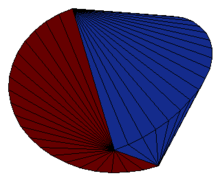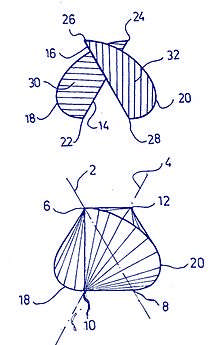Sphericon

The sphericon is a solid that has a continuous developable surface with two congruent semi circular edges, and four vertices that define a square. It is a member of a special family of rollers that, while being rolled on a flat surface, bring all the points of their surface to contact with the surface they are rolling on. It was discovered independently by Colin Roberts in the UK in 1969 [1] (who named it), and by the Israeli game and toy inventor David Haran Hirsch who patented it in Israel in 1980.[2].
Construction
It may be constructed from a bicone (a double cone) with an apex angle of 90 degrees, by splitting the bicone along a plane through both apexes, rotating one of the two halves by 90 degrees, and reattaching the two halves.[3] Alternatively, the surface of a sphericon can be formed by cutting and gluing a paper template in the form of four circular sectors (with central angles π/√2) joined edge-to-edge.[4]
Geometric properties
The surface area of a sphericon with radius r is given by:
The volume is given by:
exactly half the volume of a sphere with the same radius.
History

In 1969, Colin Roberts (a carpenter from the UK) made a sphericon out of wood while attempting to carve a Möbius strip without a hole.
In 1979 David Hirsch invented a device for generating a meander motion. The device consisted of two perpendicular half discs joined at their axes of symmetry. While examining various configurations of this device, he discovered that the form created by joining the two half discs, exactly at their diameter centers, is actually a skeletal structure of a solid made of two half bicones, joined at their square cross-sections with an offset angle of 90 degrees, and that the two objects have the exact same meander motion. Hirsch filed a patent in Israel in 1980, and a year later, a pull toy named Wiggler Duck, based on Hirsch's device was introduced by Playskool Company.
In October 1999, Colin Roberts sent Ian Stewart a package containing a letter and two sphericon models. In response, Stewart wrote an article "Cone with a Twist" in his Mathematical Recreations column of Scientific American.[5] This sparked quite a bit of interest in the shape, and has been used by Tony Phillips to develop theories about mazes, and is also used as a logo and name by the Israeli research company Sphericon Ltd.
in the SVG image, move over the image to rotate the shapes
See also
References
- ↑ "Mathematical Recreations: Cone with a Twist", Scientific American, October 1999
- ↑ David Haran Hirsch (1980): "Patent no. 59720: A device for generating a meander motion; Patent drawings; Patent application form; Patent claims
- ↑ Paul J. Roberts (2010). "The Sphericon". Archived from the original on 2012-07-23.
- ↑ A mesh at www.pjroberts.com/sphericon, archived by web.archive.org
- ↑ "Mathematical Recreations: Cone with a Twist", Scientific American, October 1999
External links
| Look up sphericon in Wiktionary, the free dictionary. |
- Sphericon construction animation at the National Curve Bank website.
- Paper model of a sphericon Make a sphericon
- Sphericon variations using regular polygons with different numbers of sides
- A Sphericon in Motion showing the characteristic wobbly motion as it rolls across a flat surface